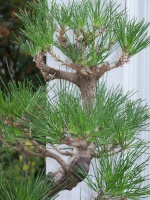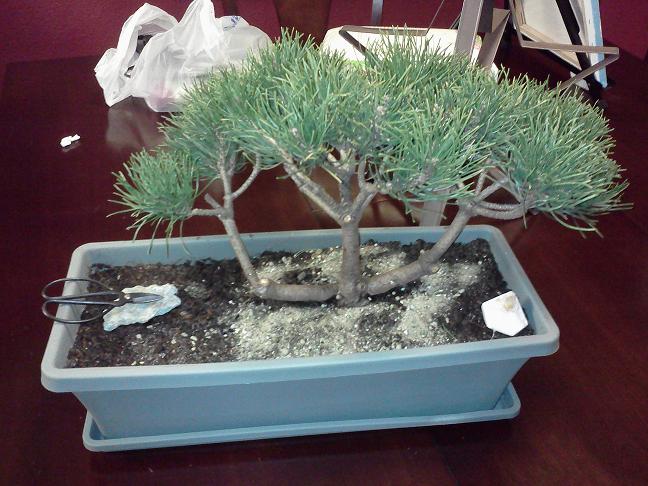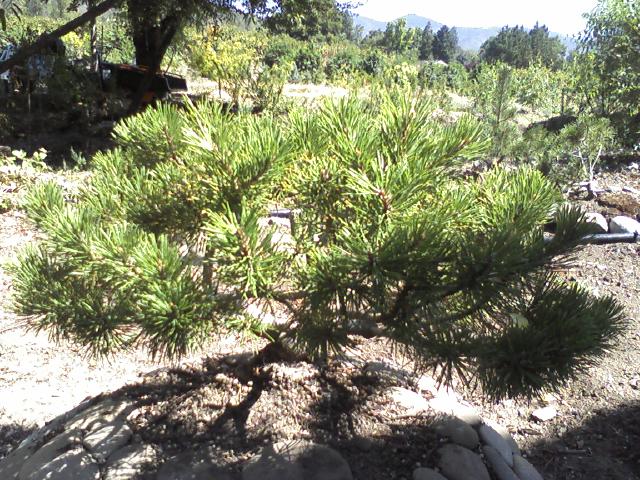mugo pine styling...
+3
lordy
MrFancyPlants
JamesRB
7 posters
Page 1 of 1
 mugo pine styling...
mugo pine styling...
I purchased two mugo pine from Home Depot...smallish but nice and strong...they are full of branches, like an octupus with two and three main-like trunks. Would it be ok to prune pack some of this branching now. I am just itching to get some clarity going in these little bushes. thanks for you advise in advance...btw boston zone 6.


JamesRB- Member
 mugho repotting and care
mugho repotting and care
I've taken out a few of these guys by being too aggressive. My advice would be to go after the roots first and then give it over a year to recover, or not, before you get too attached to the styling. Thanks for bringing up the topic.
I have two trees picked out for the Bonsai Repotting workshop at the arboretum later this month, but I realise that I may have inadvertantly picked my two easiest trees to repot just because they are both due. I put them both in more granular soil years ago, so I am hoping they will be a snap. Maybe instead I should go get a nursery mugho, since they are the real challenge horticulturally.
imrbo,
David
I have two trees picked out for the Bonsai Repotting workshop at the arboretum later this month, but I realise that I may have inadvertantly picked my two easiest trees to repot just because they are both due. I put them both in more granular soil years ago, so I am hoping they will be a snap. Maybe instead I should go get a nursery mugho, since they are the real challenge horticulturally.
imrbo,
David

MrFancyPlants- Member
 Re: mugo pine styling...
Re: mugo pine styling...
I'm hoping you can elaborate on what you meant by "too aggressive". I planted one several years ago that someone else had potted probably 5 years ago. I was eyeing it just yesterday thinking of lifting it from the tile I planted it on. Then I was reading online about mugos and it said it was better to wait til summer after candles had hardened. So I plan to wait. Cant hurt the trunk by staying in the ground a few more months.MrFancyPlants wrote:I've taken out a few of these guys by being too aggressive. My advice would be to go after the roots first and then give it over a year to recover, or not, before you get too attached to the styling. Thanks for bringing up the topic.
I have two trees picked out for the Bonsai Repotting workshop at the arboretum later this month, but I realise that I may have inadvertantly picked my two easiest trees to repot just because they are both due. I put them both in more granular soil years ago, so I am hoping they will be a snap. Maybe instead I should go get a nursery mugho, since they are the real challenge horticulturally.
imrbo,
David

lordy- Member
 Re: mugo pine styling...
Re: mugo pine styling...
It would be better to get advice from someone who has had more success with the Mughos, as I can only guess which insult did in my poorly fated subjects. One particularly nice subject, I may have not been aggressive enough with the initial repotting. I was trying to be real careful and I slip potted it into large basket with nice modern bonsai soil, but upon autopsy I found a disgusting mass off sodden clay smothering all of the roots. Another smaller and cheaper subject I trimmed back so that I could have a guess as to future design and did a more thorough job of replacing the soil. I believe my mistake that time was two major insults in one year.
I believe Vance Wood is a resident Mugho expert. Maybe he or someone else could give us some pointers.
Repot in fall? Style the next fall given sufficient growth? Maybe Mughos are just beyond my skill level.
I believe Vance Wood is a resident Mugho expert. Maybe he or someone else could give us some pointers.
Repot in fall? Style the next fall given sufficient growth? Maybe Mughos are just beyond my skill level.

MrFancyPlants- Member
 Re: mugo pine styling...
Re: mugo pine styling...
I try and stay away from anything with needles, including nurses. Just seems to work out better for me that way.MrFancyPlants wrote: Maybe Mughos are just beyond my skill level.


lordy- Member
 Re: mugo pine styling...
Re: mugo pine styling...
Hi James, I have a little experience with the mugos, particularly the nursery stock ones like you have. When you first see them they appear to be ideal stock to work with. When you take a closer look, at the inside of the tree, it is frightenly skeletal, the octopus has long tentacles with no foliage except at the ends. Here the limbs break out into crows feet, so if you look at each branch they look like little umbrellas. Have I described your tree fairly close?
Here I would like to interject that the mugo pine has been my guinea pig from the start, and my whipping boy. I did everything possible the wrong way at the wrong time. Miraculously, one of my first mugos has survived my rudest insults and was planted into the ground perched on top of a rock for a root over rock.
Ok, back to trees at hand. These nursery trees are monsters and often need major revision, just due to the way they have been previously trained. My first mugo I cut all the branches except three, more than 2/3's reduction, then reduced the root mass to fit a training pot that was way to small, more than 2/3's. The tree did not die, but it did not flinch for over two years.
I was flying by the seat of my pants trying to figure my way into pines. Judging by what I saw in nature I gave them the same treatment. Around my neck of the woods that's rain all winter and hot dry summers. How that little mugo survived I have not a clue!
Alright, I can hear Jim snortin n blow'n so I'll get to the meat of it. I would go through the limbs and remove about 1/3 of them. This will open the canopy and let some light into the interior. Mugo likes a snug fit so if the tree is happy in its pot I wouldn't repeat until you have the top reduction done down to your basic tree structure.
Take about 1/3 of the branches the need to be removed each season. Feed heavy and water lavishly at this point to encourage as much growth as possible and you will begin to see back budding in closer to the trunk. When you are doing this process you want to get as much out of the candle growth as you can and then pinch them back. How and when to pinch candles is another saga, but for growing trees or reworking trees like this I let them grow all season and remove them before new growth begins.
I know I'm getting long winded here, but there is one more thing that must be addressed with nursery stock trees, and that is the roots. The nebari is generally a disaster! What has been happening at the nursery is that as the soil leaches out of the pots the pots are 'topped off' with fresh soil, with a dose of slow release fertilizer to boot. The roots follow the juice so to speak and instead of growing downward they grow up into the upper part of the pots and circle around the base of the trunk of the tree. These are called 'strangler roots' as they wrap around the trunk. A hideous mess in bonsai terms! Nebari? What nebari?
In a season you can take 1/3 of the root mass. Before I take any roots from anywhere else I begin to remove these strangler roots. I cut them and if they will come out of the soil I pull them out. My main concern is getting them away from the trunk so the site begins to repair. It takes a few seasons to get them all untangled from the base of the trunk and get down to the actual nebari of the tree.
Do all keeping to the 1/3 rule and the one insult per season rule. All in all I would say that the nursery stock trees present alot of challenging aspects that need to be addressed to bring them to bonsai. Intensely scrutinize them before selecting one to work. Pull the branches back and get a good look inside and dig down along the roots under the first layer of soil and see what's going on down there. It better be pretty darn sweet before I'll buy another.
In closing I would just like to throw in that there are sources, reputable nurseries that produce excellent pre-bonsai stock without any of these inherent qualities. A few bucks more maybe, but money well invested putting you way ahead of the game. Hope I shed some light, Rick
Here I would like to interject that the mugo pine has been my guinea pig from the start, and my whipping boy. I did everything possible the wrong way at the wrong time. Miraculously, one of my first mugos has survived my rudest insults and was planted into the ground perched on top of a rock for a root over rock.
Ok, back to trees at hand. These nursery trees are monsters and often need major revision, just due to the way they have been previously trained. My first mugo I cut all the branches except three, more than 2/3's reduction, then reduced the root mass to fit a training pot that was way to small, more than 2/3's. The tree did not die, but it did not flinch for over two years.
I was flying by the seat of my pants trying to figure my way into pines. Judging by what I saw in nature I gave them the same treatment. Around my neck of the woods that's rain all winter and hot dry summers. How that little mugo survived I have not a clue!
Alright, I can hear Jim snortin n blow'n so I'll get to the meat of it. I would go through the limbs and remove about 1/3 of them. This will open the canopy and let some light into the interior. Mugo likes a snug fit so if the tree is happy in its pot I wouldn't repeat until you have the top reduction done down to your basic tree structure.
Take about 1/3 of the branches the need to be removed each season. Feed heavy and water lavishly at this point to encourage as much growth as possible and you will begin to see back budding in closer to the trunk. When you are doing this process you want to get as much out of the candle growth as you can and then pinch them back. How and when to pinch candles is another saga, but for growing trees or reworking trees like this I let them grow all season and remove them before new growth begins.
I know I'm getting long winded here, but there is one more thing that must be addressed with nursery stock trees, and that is the roots. The nebari is generally a disaster! What has been happening at the nursery is that as the soil leaches out of the pots the pots are 'topped off' with fresh soil, with a dose of slow release fertilizer to boot. The roots follow the juice so to speak and instead of growing downward they grow up into the upper part of the pots and circle around the base of the trunk of the tree. These are called 'strangler roots' as they wrap around the trunk. A hideous mess in bonsai terms! Nebari? What nebari?
In a season you can take 1/3 of the root mass. Before I take any roots from anywhere else I begin to remove these strangler roots. I cut them and if they will come out of the soil I pull them out. My main concern is getting them away from the trunk so the site begins to repair. It takes a few seasons to get them all untangled from the base of the trunk and get down to the actual nebari of the tree.
Do all keeping to the 1/3 rule and the one insult per season rule. All in all I would say that the nursery stock trees present alot of challenging aspects that need to be addressed to bring them to bonsai. Intensely scrutinize them before selecting one to work. Pull the branches back and get a good look inside and dig down along the roots under the first layer of soil and see what's going on down there. It better be pretty darn sweet before I'll buy another.
In closing I would just like to throw in that there are sources, reputable nurseries that produce excellent pre-bonsai stock without any of these inherent qualities. A few bucks more maybe, but money well invested putting you way ahead of the game. Hope I shed some light, Rick

RKatzin- Member
 Re: mugo pine styling...
Re: mugo pine styling...
Thank you so much for your thoughtful and entertainging responce to my question. My experience is very parallel to yours in regards to getting carried away and getting it home and waking up in the morning thinking....what in the world......You are so right with your advice in buying plants from growers that have bonsai material in mind. In the long run it makes much more good sense. However, being new to my long time facination my desire gets the better of my good judgement.....but with the help of your post I can maybe excersise some patience and maybe in a few seasons one of these pre-malsai will turn into a prize. At any rate, they are here and I will lavish lots of loving attention......and in the end isn't that all we can ever do ....lavish love!!

JamesRB- Member
 Re: mugo pine styling...
Re: mugo pine styling...
HAHA! RKATZIN, I wish I would have read your recount of your Mungo Pine story a few days ago.... But, since I didnt, I seem to have recreated your experiance thinking a mungo to be similar in pruning tolerance as a juniper hedge plant. I removed about 2/3 foliage and more than 2/3 root reduction and fit it into a training pot im thinkin might not be deep enough in retrospect. plus I repoted when it started budding when apparently I should have waited a few months... too late now... I guess all I can do now is feed water and monitor basically hope for the best.
Well I was planning on posting anyway with a question on styling my new tree when i saw this topic on the boards so I will just piggyback here if its all the same to you James...
So as many have mentioned the inside of these little trees hide a bunch of surprises, tons of branches and mine had two very large additional trunk size branches extending below the soil line making the main trunk look very appealing at the nursery but threw me for a loop when I started cleaning this thing up. I was planning on only keeping two trunks (the center and the right extension) but figured I had already gone overboard and should wait a year or two for the tree to recover before cutting off such a large branch. So I planted it in my normal soil mix (equal parts forest compost/clay absorber aggragate/ and Builder Sand) which might not drain the way this species needs from what im reading.... This tree might be doomed and I feel dumb.
My question is that if this thing does survive and it makes it to two years and bounces back, should I continue with my plan to cut the left most trunk or should I just wire the outer branches to be more asymetrical to each other or staggared (left=shortes Middle=apex right=mid) either way the middle trunk will be the apex. Please let me know what you all think about the design I chose so far for this mungo. Its so symetrical i feel as though I am breaking a bonsai styling unspoken rule...lol

Well I was planning on posting anyway with a question on styling my new tree when i saw this topic on the boards so I will just piggyback here if its all the same to you James...
So as many have mentioned the inside of these little trees hide a bunch of surprises, tons of branches and mine had two very large additional trunk size branches extending below the soil line making the main trunk look very appealing at the nursery but threw me for a loop when I started cleaning this thing up. I was planning on only keeping two trunks (the center and the right extension) but figured I had already gone overboard and should wait a year or two for the tree to recover before cutting off such a large branch. So I planted it in my normal soil mix (equal parts forest compost/clay absorber aggragate/ and Builder Sand) which might not drain the way this species needs from what im reading.... This tree might be doomed and I feel dumb.
My question is that if this thing does survive and it makes it to two years and bounces back, should I continue with my plan to cut the left most trunk or should I just wire the outer branches to be more asymetrical to each other or staggared (left=shortes Middle=apex right=mid) either way the middle trunk will be the apex. Please let me know what you all think about the design I chose so far for this mungo. Its so symetrical i feel as though I am breaking a bonsai styling unspoken rule...lol

gaetama50- Member
 Re: mugo pine styling...
Re: mugo pine styling...
If you plant just a llittle bit deeper, and wire some different directions in the trunks, you have the making of a 3-tree raft planting here.
I think I would remove that drip tray from underneath the pot. Pines, in general, do not like their rots to be constantly wet. It is OK AS you water, but remove quickly it to let the pot drain.
I think I would remove that drip tray from underneath the pot. Pines, in general, do not like their rots to be constantly wet. It is OK AS you water, but remove quickly it to let the pot drain.

JimLewis- Member
 Re: mugo pine styling...
Re: mugo pine styling...
Thanks for the advice Jim, I will definately only use the drip tray for display purposes between waterings... and The three trunk raft Idea is a good one.... thats how i picked up the tree from the nursery (buried deeper covering the bottom of the trunks) after a year or two I will definately keep that option open as I dont think i can train growth to the bottom of the main trunk to raise the other two on the plant.
gaetama50- Member
 Re: mugo pine styling...
Re: mugo pine styling...
Hi to all, that's a great pic Gaetama, really shows the structure of these nursery stock trees. The nurserymen really do a good job creating that outer shell and that is what they want.
Jim, rafting is a great idea for these trees! I might take Gaetama's tree a little further than three. I would take all the limbs from the left side and lay the tree on that side. Then remove the stems from the right side of the right trunk and lay it down to make about seven little new trunks.
Or, and it is the long way around, but, once you open these trees up and allow the sun into the interior they do backbud. You have to come out of the small pots and into a grow-box or the garden. Keep them in full sun and feed and water lavishly. A well draining soil mix is a must, very loose and chunky.
Once you begin to get some backbuding you want to use the existing foilage to feed your new buds, while gradually removing the old branches. I remove the candles from branches I'm going to remove. I don't want them gaining any strength.
Removing about 1/3 of the branches a year you will have all the old branches removed and your new tree established in five years or so. Another five years for styling and you're looking at ten years at least to convert these trees.
Start with good stock and put ten years on it and you've really got something, I would think. I'm working my way through a few of these. Here is one, the last of these I got. Still hadn't learned my lesson, but I think it is one of the best structured one I seen and it is coming along.

when I bought it
in the garden


This is the root over rock

This is the mugo that refused to die, a real trooper, still carrying on the good fight!
Jim, rafting is a great idea for these trees! I might take Gaetama's tree a little further than three. I would take all the limbs from the left side and lay the tree on that side. Then remove the stems from the right side of the right trunk and lay it down to make about seven little new trunks.
Or, and it is the long way around, but, once you open these trees up and allow the sun into the interior they do backbud. You have to come out of the small pots and into a grow-box or the garden. Keep them in full sun and feed and water lavishly. A well draining soil mix is a must, very loose and chunky.
Once you begin to get some backbuding you want to use the existing foilage to feed your new buds, while gradually removing the old branches. I remove the candles from branches I'm going to remove. I don't want them gaining any strength.
Removing about 1/3 of the branches a year you will have all the old branches removed and your new tree established in five years or so. Another five years for styling and you're looking at ten years at least to convert these trees.
Start with good stock and put ten years on it and you've really got something, I would think. I'm working my way through a few of these. Here is one, the last of these I got. Still hadn't learned my lesson, but I think it is one of the best structured one I seen and it is coming along.

when I bought it
in the garden


This is the root over rock

This is the mugo that refused to die, a real trooper, still carrying on the good fight!

RKatzin- Member
 Re: mugo pine styling...
Re: mugo pine styling...
Thanks for the suggestions and advice Rkatzan, I have a lot of options now that I didn't originally see. Its a lot to think over but as you said I have 5 to 10 years before this tree will really come into its own and I have another year or two to figure out what I want to do with it. I think I will definitely take your advice and plant it in the ground when I move back to the east coast and let it gain some real trunk strength and try to get some back budding going hopefully by the time I replant it i will have made up my mind and have a design plan for this tree to show you all. Thanks again. and great pics too... I would love to see them again when you thin them out to see what kind of trunk structure you are working with and what you do with them.
gaetama50- Member
 mugho pine repotting
mugho pine repotting
I know of very few mugho pine bonsai in our area, which is strange, as black pines aren't available here.
I suspect they are touchy about repotting, so I am conservative an try to do it a pointe. A recent article in "Bonsai4me" (who is he? Anyone know?) suggested they don't like to be potted int he Spring, but prefer the Summer. This is a little curious. I suspect one reason for the repeated failures i see is that people keep going for the special varieties, which are known to be temperamental.
I suspect they are touchy about repotting, so I am conservative an try to do it a pointe. A recent article in "Bonsai4me" (who is he? Anyone know?) suggested they don't like to be potted int he Spring, but prefer the Summer. This is a little curious. I suspect one reason for the repeated failures i see is that people keep going for the special varieties, which are known to be temperamental.
TheMulletRapper- Member
 Similar topics
Similar topics» Small mugo pine first styling
» Mugo Pine first styling
» Mugo pine styling help
» Styling of a mugo pine
» Twisted Mugo pine -first styling-
» Mugo Pine first styling
» Mugo pine styling help
» Styling of a mugo pine
» Twisted Mugo pine -first styling-
Page 1 of 1
Permissions in this forum:
You cannot reply to topics in this forum






